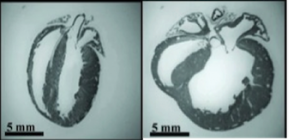
Researchers explore what happens when heart cells fail

Through a grant from the United States-Israel Binational Science Foundation, Biomedical Engineering Associate Professor Naomi Chesler will embark upon a new collaborative research project to better understand heart function and failure. “This is unique opportunity to combine theoretical and the experimental approaches and to develop a collaboration with an Israeli investigator,” Chesler says.
Chesler will work with Richard Moss, the UW-Madison School of Medicine and Public Health associate dean for basic research, biotechnology and graduate studies; and with Amir Landesberg, dean of Biomedical Engineering at Technion-Israel Institute of Technology.
Landesberg has developed a novel model of heart function at the cellular level, while Chesler’s team has been improving methods to study heart function at the whole organ level in small animal models. Moss not only has expertise in experimental measurement of heart function at the cellular level, but also genetically engineered mice that have a mutation in one protein in the cells of the heart that generate force that leads to dilation and dysfunction.
These mice will allow Chesler and Moss to test the theoretical model developed by Landesberg.
While Moss will oversee the group that breeds the mice, Chesler will oversee experimental treatment of the mice.
Chesler also hopes to learn more about the mathematical model of heart cell function, which is Landesberg’s expertise. Models, such as the one used by Landesberg, help bridge the gap in understanding functions in mice and functions in humans.
“We are hoping to understand what happens in people with heart disease. If we better understand heart cell function and dysfunction, we might be able to develop better metrics of early dysfunction,” Chesler says. “If we find early dysfunction in people, then we might be able to treat them earlier and actually prevent heart failure.”
###
Provided by University of Wisconsin-Madison
View original article